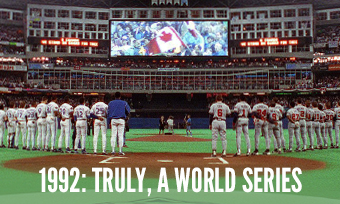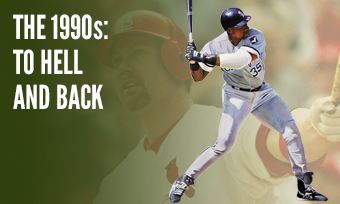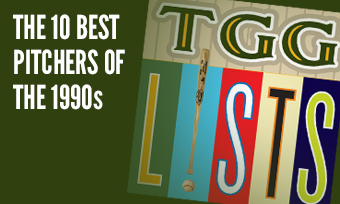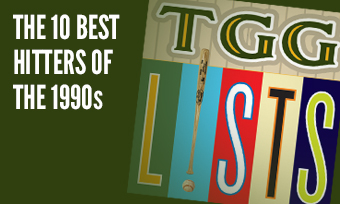The Yearly Reader
Leaders and Honors, 1992
Our list of baseball’s top 10 hitters and pitchers in both the American League and National League for the 1992 baseball season, as well as the awards and honors given to the game’s top achievers of the year.
The National League’s Top 10 Hitters, 1992
Bold type in brick red indicates league leader.
1. Barry Bonds, Pittsburgh
Key Numbers: .140 games, .311 average, 109 runs, 36 doubles, 5 triples, 34 home runs, 103 RBIs, 127 walks, 32 intentional walks, 39 stolen bases, .456 on-base percentage, .624 slugging percentage.
In his final year at Pittsburgh, Bonds produced a 1.080 OPS (on-base plus slugging percentages), highest in the NL since 1969; if that wasn’t impressive enough, it would be below the 1.143 he would average for the rest of his career.
2. Andy Van Slyke, Pittsburgh
Key Numbers: .324 average, 103 runs, 199 hits, 45 doubles, 12 triples, 14 home runs, 89 RBIs, 12 stolen bases.
While Bonds went nowhere but up, Van Slyke’s 1992 output would represent a last hurrah; he would hit just .261 over three more injury-riddled seasons.
3. Gary Sheffield, San Diego
Key Numbers: .330 average, 87 runs, 184 hits, 34 doubles, 33 home runs, 100 RBIs.
After years of off-field squabbling and poor on-field performance—he even confessed that he purposely made errors to get out of Milwaukee—Sheffield found solace in San Diego and finally achieved the potential so many had instantly expected of him as a rookie Brewer in 1989.
4. Fred McGriff, San Diego
Key Numbers: .286 average, 79 runs, 30 doubles, 35 home runs, 104 RBIs, 96 walks, 23 intentional walks.
McGriff became the first player in the post-1900 modern era to lead both leagues in home runs, having paced the AL for Toronto in 1989.
5. Ryne Sandberg, Chicago
Key Numbers: .304 average, 100 runs, 186 hits, 32 doubles, 8 triples, 26 home runs, 87 RBIs, 17 stolen bases.
After being given a revised contract that made him baseball’s highest annually paid player (at $7.1 million), Sandberg responded with would be the last comprehensively solid campaign of his career.
6. Darren Daulton, Philadelphia
Key Numbers: .270 average, 80 runs, 32 doubles, 5 triples, 27 home runs, 109 RBIs, 88 walks, 11 hit-by-pitches, 11 stolen bases.
A part-time catcher for much of his previous eight seasons with the Phillies, Daulton exploded with career highs in home runs and RBIs.
7. Ray Lankford, St. Louis
Key Numbers: .293 average, 87 runs, 175 hits, 40 doubles, 6 triples, 20 home runs, 86 RBIs, 147 strikeouts, 42 stolen bases, 24 caught stealing.
Lankford’s complete offensive game thrilled Cardinals fans into thinking they had their second Lou Brock.
8. Larry Walker, Montreal
Key Numbers: .301 average, 85 runs, 31 doubles, 23 home runs, 93 RBIs, 18 stolen bases.
The British Columbia native became the first Canadian-born player to win local honors as the Expos’ player of the year.
9. Dave Hollins, Philadelphia
Key Numbers: .270 average, 104 runs, 28 doubles, 27 home runs, 93 RBIs, 19 hit-by-pitches.
A career year for the young, hard-nosed third baseman—and although he would occasionally have a couple more good years, stardom would prove elusive due to a later diabetes diagnosis.
10. Terry Pendleton, Atlanta
Key Numbers: .311 average, 98 runs, 199 hits, 39 doubles, 21 home runs, 105 RBIs.
A strong follow-up for the reigning NL MVP, who put together numbers every bit as good.
The American League’s Top 10 Hitters, 1992
1. Frank Thomas, Chicago
Key Numbers: .323 average, 108 runs, 185 hits, 46 doubles, 24 home runs, 115 RBIs, 122 walks, .439 on-base percentage.
Sixteen of the Big Hurt’s 24 home runs were solo—and yet he still accumulated a broad number of RBIs.
2. Edgar Martinez, Seattle
Key Numbers: .343 average, 100 runs, 181 hits, 46 doubles, 18 home runs, 73 RBIs, 14 stolen bases.
A year before a devastating preseason injury turned him into a full-time DH, Martinez collected the first of two career batting titles while manning the bag at third base.
3. Kirby Puckett, Minnesota
Key Numbers: .329 average, 104 runs, 210 hits, 38 doubles, 19 home runs, 110 RBIs, 17 stolen bases.
For the fifth and final time in his career, Puckett racked up over 200 hits.
4. Roberto Alomar, Toronto
Key Numbers: .310 average, 105 runs, 177 hits, 27 doubles, 8 triples, 8 home runs, 76 RBIs, 90 walks, 49 stolen bases.
Gradually growing into an even better presence than the Blue Jays had imagined when they traded for him a couple of years earlier, Alomar hit .354 at home—and .354 with runners in scoring position.
5. Mark McGwire, Oakland
Key Numbers: 139 games, .268 average, 87 runs, 42 home runs, 104 RBIs, 90 walks, .585 slugging percentage.
Strong comeback showing for Big Mac, who nearly doubled his home run output of a year earlier and hit for a decent average after batting a Dave Kingman/Rob Deer-like .223 over the previous three seasons.
6. Brady Anderson, Baltimore
Key Numbers: .271 average, 100 runs, 28 doubles, 10 triples, 21 home runs, 80 RBIs, 98 walks, 53 stolen bases.
People were surprised to see prototypical leadoff guy Anderson, who in four previous seasons batted no higher than .231 through part-time duty, crush 21 home runs; wait until they see what he had in store for them in 1996.
7. Paul Molitor, Milwaukee
Key Numbers: .320 average, 89 runs, 195 hits, 36 doubles, 7 triples, 12 home runs, 89 RBIs, 31 stolen bases.
In his last year with the Brewers before signing on with Toronto, Molitor fattened on more stats that would make him #2 on many all-time Milwaukee lists, behind long-time teammate Robin Yount.
8. Rickey Henderson, Oakland
Key Numbers: 117 games, .283 average, 77 runs, 15 home runs, 46 RBIs, 95 walks, 48 stolen bases.
Numerous stays on the shelf possibly kept Rickey from winning yet another stolen base crown and setting a career high in walks.
9. Danny Tartabull, New York
Key Numbers: 123 games, .266 average, 25 home runs, 85 RBIs, 103 RBIs.
Now with the Yankees, Tartabull showed the same sort of on-and-off chemistry that frayed on the Royals—but when he was on, as he definitely was on September 8 when he had five hits and nine RBIs at Baltimore—wow.
10. Ken Griffey Jr., Seattle
Key Numbers: .308 average, 83 runs, 174 hits, 39 doubles, 27 home runs, 103 RBIs, 10 stolen bases.
Thanks to the exciting hitting exploits of Junior and batting titlist teammate Edgar Martinez, the Mariners were watchable at 64-98.
The National League’s Top 10 Pitchers, 1992
1. Greg Maddux, Chicago
Key Numbers: 2.18 ERA, 20 wins, 11 losses, 35 starts, 268 innings, 14 hit-by-pitches, 26 stolen bases allowed.
Maddux made the most of what many believed was a “salary drive” campaign, becoming a free agent with a sterling, Cy Young Award-winning performance; it was actually the beginning of an impressive reign.
2. Bob Tewksbury, St. Louis
Key Numbers: 2.16 ERA, 16 wins, 5 losses, .762 win percentage, 32 starts, 233 innings, 20 walks, 25 grounded into double plays.
Mixing up various curves and a fastball barely registering 85 MPH, Tewksbury posted the NL’s best walk rate per nine innings (0.773) since Red Lucas in 1933.
3. Curt Schilling, Philadelphia
Key Numbers: 2.35 ERA, 14 wins, 11 losses, 2 saves, 1 blown save, 42 appearances, 26 starts, 10 complete games, 226.1 innings.
Two months after an early-season graduation to the rotation, a young Schilling set a personal mark by throwing 30.1 straight shutout innings. Not a bad return for the Phillies after obtaining him from the Astros, one-up, for Jason Grimsley.
4. Dennis Martinez, Montreal
Key Numbers: 2.47 ERA, 16 wins, 11 losses, 32 starts, 226.1 innings, 22 stolen bases allowed, 17 caught stealing/picked off.
Tougher than ever to get a hit off of, Martinez set career lows in opposing batting average (.211) and on-base percentage (.273); even those who got on then had troubles, as noted in the caught stealing/picked off note above.
5. Tom Glavine, Atlanta
Key Numbers: 2.76 ERA, 20 wins, 8 losses, .714 win percentage, 33 starts, 5 shutouts, 225 innings.
Glavine’s second straight successful dance with 20 wins including a streak of 13 straight triumphs in midseason.
6. Bill Swift, San Francisco
Key Numbers: 2.08 ERA, 10 wins, 4 losses, 1 save, 30 appearances, 22 starts, 164.2 innings, 43 walks, 26 grounded into double plays.
The third Giant in 10 years (after Atlee Hammaker and Scott Garrelts) to sneak away with the NL ERA crown, Swift ensured the title even after a nerve injury reduced his activity to long relief duty in September.
7. Doug Jones, Houston
Key Numbers: 1.85 ERA, 11 wins, 8 losses, 36 saves, 6 blown saves, 80 appearances, 111.2 innings, 17 walks.
The reliever appeared often and effectively, but no one outside of Houston seemed to notice.
8. Mike Morgan, Chicago
Key Numbers: 2.55 ERA, 16 wins, 8 losses, 34 starts, 240 innings, 11 wild pitches, 29 grounded into double plays.
Now on major league team #7, the well-traveled Morgan hit his career acme with his best record and (almost) best ERA.
9. Jose Rijo, Cincinnati
Key Numbers: 2.56 ERA, 15 wins, 10 losses, 33 starts, 211 innings, 44 walks.
With a voodoo doll and snake oil placed in his locker for good luck, Rijo continued to put a hex on opposing hitters.
10. Doug Drabek, Pittsburgh
Key Numbers: 2.77 ERA, 15 wins, 11 losses, 34 starts, 10 complete games, 256.2 innings, 11 wild pitches, 20 grounded into double plays.
Before becoming part of the voluminous exodus of free-agent ex-Pirates, Drabek wrapped up a Pittsburgh tenure with a 3.02 ERA—the second lowest by a Bucs starter (500 innings minimum) since the end of the Deadball Era.
The American League’s Top 10 Pitchers, 1992
1. Roger Clemens, Boston
Key Numbers: 2.41 ERA, 18 wins, 11 losses, 32 starts, 11 complete games, 5 shutouts, 246.2 innings, 24 stolen bases, 28 grounded into double plays.
The Red Sox were 21-11 when Clemens, who grabbed his third straight AL ERA title, started; they were 52-78 when he didn’t.
2. Mike Mussina, Baltimore
Key Numbers: 2.54 ERA, 18 wins, 5 losses, .783 win percentage, 32 starts, 241 innings.
In his first full year, the future Hall of Famer didn’t get intimidated by the bandbox dimensions at brand-new Oriole Park at Camden Yards. Opponents hit just .175 with a single home run in 154 at-bats when runners were in scoring position.
3. Charles Nagy, Cleveland
Key Numbers: 2.96 ERA, 17 wins, 10 losses, 33 starts, 252 innings, 12 stolen bases allowed, 15 caught stealing/picked off, 34 grounded into double plays.
A strong breakout year for the 25-year-old Nagy, pitching a scoreless inning in the All-Star Game and winning 17 games while no other Cleveland starter collected more than six.
4. Kevin Brown, Texas
Key Numbers: 3.32 ERA, 21 wins, 11 losses, 35 starts, 11 complete games, 265.2 innings, 10 hit-by-pitches, 29 grounded into double plays.
The steady-handed Brown became a fixture on a Texas staff that to many baseball fans—even Rangers fans—seemed to consist only of Nolan Ryan.
5. Dennis Eckersley, Oakland
Key Numbers: 1.91 ERA, 7 wins, 1 loss, 51 saves, 3 blown saves, 69 appearances, 80 innings, 11 walks.
At the end of his incredible reign as the game’s elite closer—his ERA would catapult from the 1.00’s to the 4.00’s starting in 1993—Eckersley wasn’t at his absolute stingiest, but was clearly valuable enough to take home both the AL MVP and Cy Young Award plaques.
6. Kevin Appier, Kansas City
Key Numbers: 2.46 ERA, 15 wins, 8 losses, 30 starts, 208.1 innings.
Appier turned in a strong record despite playing on a losing (72-90) Royals team and getting a paltry 3.4 runs per start, among the lowest in baseball.
7. Jim Abbott, California
Key Numbers: 2.77 ERA, 7 wins, 15 losses, 29 starts, 211 innings, 22 grounded into double plays.
The one-handed lefty wasn’t afforded the same kind of luck as Appier on another 72-90 team; the Angels notched 1.6 runs when he didn’t win—and it wasn’t much higher even when he did earn the W.
8. Jack McDowell, Chicago
Key Numbers: 3.18 ERA, 20 wins, 10 losses, 34 starts, 13 complete games, 260.2 innings, 29 stolen bases allowed.
The White Sox workhorse jumped out to a big-time start, winning each of his first seven starts on the way to his first 20-win campaign.
9. Juan Guzman, Toronto
Key Numbers: 2.64 ERA, 16 wins, 5 losses, .762 win percentage, 28 starts, 180.2 innings, 14 wild pitches, 27 stolen bases allowed.
Lost amid the optics of a star-studded Blue Jays team, the second-year Guzman allowed just six home runs, gave up an anemic .207 batting average and had his most productive season in a three-year, 40-11 spurt to begin his career.
10. Jaime Navarro, Milwaukee
Key Numbers: 3.33 ERA, 17 wins, 11 losses, 34 starts, 246 innings, 23 grounded into double plays.
The 25-year-old right-hander appeared to be on a nice trajectory toward stardom, but the coming live-ball era would not be kind to him; from 1993 through to the end of his major league career in 2000, he posted a 5.29 ERA.









